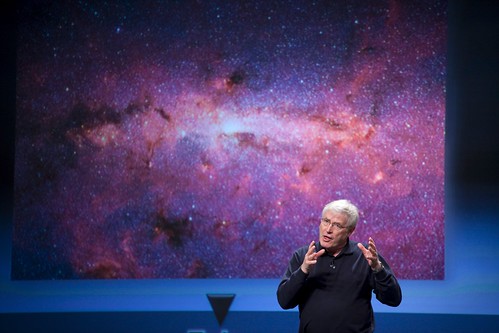I’m blogging from Camden, Maine, at the wonderful Pop!Tech conference. This year’s a special treat. My wife, the lovely Velveteen Rabbi, and I are team-blogging, trading off posts. You can read her posts on her website, or just read all of ours on the Pop!Tech site, where Michelle Riggen-Ransom has been doing brilliant work thus far. There’s lots of bloggers in the crowd and on twitter – follow the #poptech tag for lots of different perspectives.
Tony Hey, in charge of external research for Microsoft, is interested in the impact of digital data across all fields – not just science, but the humanities as well. Thousands of years ago, he tells us, people were looking at the stars to understand celestial mechanics – they wrote down and shared their observations. This was the beginning of experimental science. Not until the 1600s did we see the emergence of theoretical structures to predict scientific behavior in the work of Kepler and Newton – they introduced a second paradigm forcus on generalization and theory.
We’re now moving towards a third paradigm: computational science. This is the only ways we can look at problems like climate change and galaxy formation, Hey tells us. And there’s a fourth paradigm – data-intensive science, where we examine massive data sets to make new kinds of discoveries.
Hey believes that scientists need to think about and explain how scientific discovery happens in this new, fourth paradigm. He’s asked scientists to share essays on the topic, and they’ve been published in a creative commons, downloadable book called “The Fourth Paradigm“.

Tony Hey. photo by Kris Krüg
To fully embrace this fourth paradigm of data-intensive science, we need lots of scientists. Hey references his colleague Curtis Wong, who’s pioneered the WorldWide Telescope, a program that turns your computer into a telescope using data collected from the best telescopes around the world. WorldWide Telescope powers Galaxy Zoo, a site that lets “citizen scientists” classify galaxies by their shape. Citizens can do real science – Hey points us to the Hanny van Arkle’s object, the bluest galaxy we’ve ever seen. The galaxy was discovered by a Dutch schoolteacher, and it’s now a target for exploration with the Hubble telescope.
Other citizen science projects include “Fold It“, a computer game about protein folding which actually forward research on genetics, proteins and molecular structure. Another project invites students to run scenarios about global warming on their home and classroom computers based on a wide range of starting parameters – by running these simulations, schoolkids can discover that global warming may evolve very differently based on minor changes in starting parameters.
For these models of citizen science to work, Hey recommends a model: engage the viewer, build mental models, and access reference material to validate. You need to draw viewers in, help them understand what they’re seeing through a scientific model and then confirm those models with data and through authoritative sources.
Trying to open science to a larger audience, Hey tells us about Project Tuva. This is an unpacking of seven physics lectures by Richard Feynmann. Bill Gates was so fascinated by the lectures, he personally negotiated the ability to stream the videos. They’ve been enhanced with hyperlinks to Wikipeda and other supporting media, and full text search that indexes the video.
So what about the humanities? Hey shows us a video of the eHeritage project launched by Microsoft Asia. The goal is “preserving cultural heritage through advanced computing research.” One project reconstructs objects before they went through the weathering process. Another creates rotatable models of jade objects and one animates traditional Chinese paintings.
The example that’s most compelling to the Pop!Tech audience is the remarkable Photosynth. It’s a program that sews together images into moveable three-D models. Using photos posted online of the Camden Opera House, Hey and his team have assembled a beautiful model of the inside of the Pop!Tech venue. It’s a very impressive demonstration of a technology that could be very powerful for visualizing ancient historical and archeological sites.